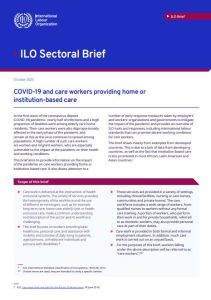Join getAbstract to access the summary!

Join getAbstract to access the summary!
International Labour Organization
COVID-19 and Care Workers Providing Home or Institution-Based Care
ILO Sectoral Brief
ILO, 2020
What's inside?
Learn how the COVID-19 pandemic has affected care workers – and what can be done to support them.
Recommendation
The International Labour Organization shines a spotlight on the plight of care workers during the COVID-19 pandemic in an informative brief. The paper highlights the disproportionate impact care workers have suffered during the pandemic crisis, calling on governments, employers and sectoral organizations to support decent working conditions for these essential workers. Issued in October 2020, the brief draws attention to longstanding challenges in the care sector and looks toward creating resilience and equity in the sector post-pandemic.
Summary
About the Author
An agency of the United Nations, the International Labour Organization brings together governments, employers and workers of 187 member states to promote decent work for all women and men.


















Comment on this summary